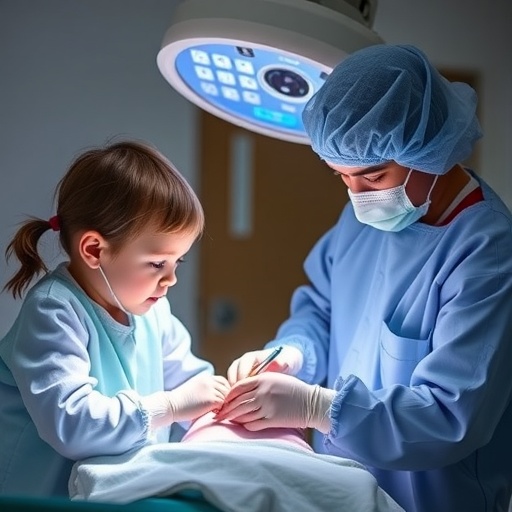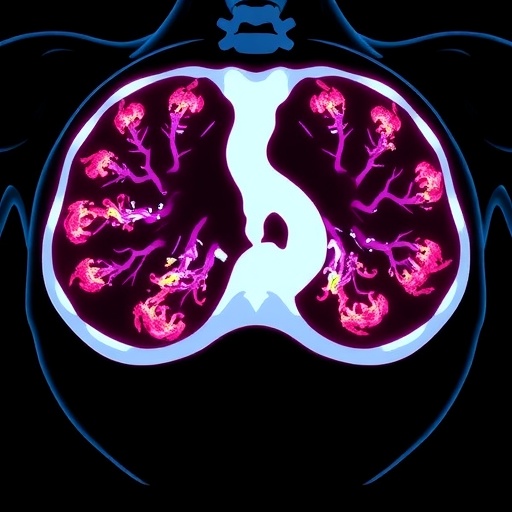In a groundbreaking exploration of pediatric radiology, researchers led by Rawashdeh et al. have delved into the crucial issue of variability in iodinated contrast media delivery across a plethora of international healthcare settings. As medical imaging technologies continue to evolve and become critical in diagnosing and treating ailments in children, the standardization of contrast media administration emerges as an essential factor to ensure optimal patient outcomes. The study sheds light on the disparities and inconsistencies in the practices surrounding this vital aspect of pediatric imaging.
Understanding the complexity of iodinated contrast media is integral to this discourse. Iodinated contrast agents, frequently utilized in diagnostic imaging, enhance the visibility of internal structures on radiological images. When administered correctly, these media significantly improve the accuracy of diagnoses. However, the variability in dosage and administration techniques poses challenges that can lead to suboptimal imaging results and potentially adverse outcomes for young patients.
The research highlights the wide-ranging discrepancies observed between different countries’ practices. Factors influencing this variability include differences in medical guidelines, access to education and training for radiology practitioners, and cultural attitudes toward healthcare. These disparities underscore the necessity for an international dialogue to establish best practices in pediatric iodinated contrast media use, ensuring consistency and safety across diverse healthcare systems.
Furthermore, the authors assert that the lack of standardization in pediatric imaging can have repercussions that extend beyond individual patient outcomes. The research community must work in tandem with regulatory bodies to formulate comprehensive guidelines that are not only evidence-based but also tailored to the specific needs of pediatric populations. Such an initiative could pave the way for improved imaging practices globally, ultimately leading to enhanced diagnostic precision and patient care.
Key findings from the study indicate that many practitioners lack access to the latest research and training that is pivotal in guiding their use of iodinated contrast media. This disconnect can lead to outdated practices being perpetuated in clinical settings, emphasizing the need for robust educational resources and training programs for radiology professionals. By harnessing technology, such as online training modules and webinars, the medical community can disseminate crucial information quickly and efficiently, bridging the knowledge gap prevalent among practitioners.
In addition to educational resources, the study advocates for the establishment of international registries that document contrast media usage. These registries could facilitate data sharing among countries, allowing for real-time analysis and a better understanding of the implications of various practices. With comprehensive data at their fingertips, researchers and clinicians alike would be better positioned to identify trends, measure outcomes, and adjust protocols accordingly.
Moreover, the research draws attention to the emerging role of artificial intelligence (AI) in pediatric radiology. As machine learning algorithms become more sophisticated, they hold significant potential in analyzing imaging data and refining the delivery of iodinated contrast media. AI can assist radiologists in determining optimal dosages based on a child’s specific characteristics, such as age, weight, and medical history. Leveraging AI technology could minimize the guesswork inherent in current practices, leading to safer and more effective imaging strategies.
One of the challenges highlighted in this study is the varying healthcare infrastructure among countries. In regions with limited resources, the availability of iodinated contrast media can be inconsistent, and healthcare providers may resort to improvisation in administration practices to achieve diagnostic goals. Standardizing practices must take into account the diverse capabilities of healthcare systems worldwide, ensuring that any recommendations are feasible and applicable in various contexts.
As the medical community grapples with these disparities, it becomes increasingly imperative to foster cooperative international research efforts. Collaborative studies that transcend borders can generate a wealth of data, capturing the nuances of pediatric iodinated contrast media use in different environments. Such partnerships would not only enhance the collective knowledge base but also foster a sense of solidarity among healthcare professionals dedicated to advancing pediatric care.
Within the scope of this research, it is also vital to involve parents and guardians in discussions about iodinated contrast media usage. As healthcare providers, it is our responsibility to ensure that families are well-informed about the procedures their children undergo. Effective communication can help alleviate anxiety, empower parents, and foster a collaborative atmosphere in decision-making concerning their child’s care.
In addition to enhancing knowledge and practice standards, advocacy for policy changes at the governmental level is crucial. Policymakers should prioritize pediatric health initiatives that support access to modern imaging techniques and standardized practices. By investing in pediatric radiology, governments can pave the way for improved outcomes, ultimately benefitting public health and alleviating the burdens on healthcare systems.
As the study concludes, it is clear that addressing the variability in pediatric iodinated contrast media delivery demands a concerted effort across multiple fronts. Through comprehensive education, collaborative research, technological innovation, stakeholder engagement, and advocacy for policy change, the medical community can work towards a future where safe and effective imaging practices are universally accessible to all children, regardless of where they receive care.
The call to action is clear: it is time to transcend guesswork in pediatric radiology. By addressing these discrepancies head-on, we can establish a new standard of care that prioritizes the well-being of the youngest patients, ensuring that every child receives the highest quality of diagnostic care without compromise.
Subject of Research: Variability in pediatric iodinated contrast media delivery.
Article Title: Beyond guesswork: addressing the wide variability in pediatric iodinated contrast media delivery from an international perspective.
Article References:
Rawashdeh, M., Ali, M.A., Bouhssine, Z. et al. Beyond guesswork: addressing the wide variability in pediatric iodinated contrast media delivery from an international perspective.
Pediatr Radiol (2025). https://doi.org/10.1007/s00247-025-06411-2
Image Credits: AI Generated
DOI: https://doi.org/10.1007/s00247-025-06411-2
Keywords: Pediatric radiology, iodinated contrast media, standardization, international practices, healthcare disparities.
Tags: best practices in imagingcontrast agent dosage variabilitydiagnostic imaging accuracyenhancing visibility in radiological imageshealthcare cultural attitudesinternational healthcare disparitiesiodinated contrast media administrationmedical imaging in childrenpediatric patient outcomespediatric radiology standardsradiology education and trainingstandardization of medical procedures





